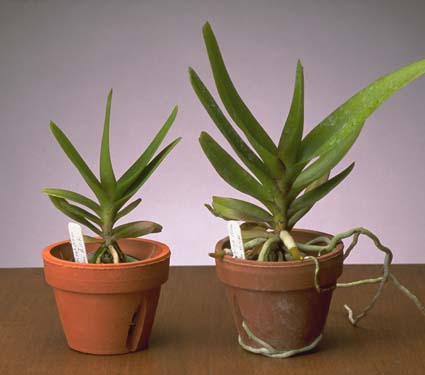|
Welcome to the AOS Beginner's Newsletter. We will be sending you monthly tips on how to grow orchids and help you get them to bloom again. In addition to the information presented here, we invite you to visit the AOS website at www.aos.org and check out the information found under ORCHID INFORMATION > ORCHID BASICS.
F E E D M E !

If their other requirements are met, orchids will grow and flower for fairly long periods without fertilizer. Witness the many people in tropical areas such as South Florida who grow them mounted on trees and let nature do the rest. Indeed, that is how epiphytic orchids grow in nature! But orchid hobbyists generally try to give their orchids more than bare minimum so that the plants flower at or above their potential.
There are many different points of view on how to fertilize orchids and what fertilizer to use. Everyone has a favorite fertilizer or supplement. There are so many variables that how and when you fertilize depends on what kinds of orchids you grow and how and where you grow them. This newsletter will offer a brief explanation and general guidelines on fertilizing orchids. For more specific application, join your local orchid society and ask someone there who grows the same kind of orchids as you. It is unlikely that you will kill any orchids with orchid fertilizer so following the recommendations here will provide your plants needed nutrition.
If you are a gardener you are probably familiar with the N-P-K listings on fertilizer bags. Orchid fertilizers have them too! Let's go over these three elements and see how they affect plant growth. "N" stands for nitrogen. Nitrogen helps make plants green, and helps them grow faster. It is the element responsible for vegetative growth – the leafy parts. "P" stands for phosphorus which is good for root growth, disease resistance, seed and fruit growth, and especially for blooming and flowering. "K" is for potassium which helps with increasing root growth, drought resistance, and disease resistance.
There are three main types of fertilizers used for orchids: balanced, high nitrogen and bloom booster. Balanced fertilizers have been traditionally recommended for use with orchids potted in inorganic potting media such as lava rock and Aliflor, and tree fern (which has fallen out of favor due to conservation concerns). Plants mounted on cork bark or other substrates also benefit from using a balanced fertilizer. An example of a balanced fertilizer would be represented by the numbers, 20–20–20. High nitrogen fertilizers have long been recommended for use with orchids potted in fir bark or fir bark mixes. The reason for extra nitrogen is that the bacteria which cause the bark to decay use up much of the available nitrogen, thus depleting the orchid. This practice has recently come into question. Nonetheless, using a high nitrogen fertilizer, especially in spring at the beginning of the growing season, can promote strong vegetative growth under ideal growing conditions. An example of high nitrogen fertilizer would be 30–10–10. Bloom, or blossom booster formulas are high in phosphorus. Typically, high phosphorus fertilizers are applied every other week for 4–6 applications the season before expected bloom. For winter-spring blooming orchids bloom booster is usually applied in the fall. Vandaceous hybrids and other orchids that bloom throughout the year can be given bloom booster every third or fourth feeding. An example of a bloom booster would be 10–30–20. Fertilizers used on orchids should contain little or no urea. This is because soil organisms must first convert the nitrogen in urea to a form useable by plants, and since orchids do not grow in soil, this conversion does not occur efficiently.

How fertilizer is applied varies as much as orchids themselves. Typically, plants are fertilized once a week during spring and summer and every two weeks in the fall and winter. Regardless of the fertilizer that you choose to use, most experienced growers use ½ the label-recommended strength. Remember, in nature epiphytic orchids' roots are exposed and the only nutrients they get are bird and animal droppings, decaying insects and detritus. The old saying fertilizing orchids is: feed them weekly weakly. Fertilizer is best applied in the morning on sunny days. For mounted orchids, or orchids with their roots exposed such as vandas in empty baskets, many growers routinely pre-water the plants and then follow with fertilizer a half hour later. The pre-watering prepares the spongy velamen of the orchid roots to better utilize the fertilizer. Orchids in pots are usually not pre-watered but some growers have their own techniques.
There are requirements specific to certain orchids. For instance, do not fertilize nobile dendrobiums after early autumn. This rule actually applies to all orchids that have decided rest periods and all deciduous orchids. Fertilizing them while in their rest period keeps them in continual growth instead of resting before producing flowers. In other words, you may get a lot of growth and no flowers.
There are also many "secret recipes" growers use that supposedly produce stronger plants or more flowers. Certainly vitamins and micro-nutrients are as essential as the building blocks of plant growth mentioned above. Elements such as magnesium, boron, calcium, carbon etc. are required for strong plant growth, but their discussion is beyond this newsletter. All in all, although there are certain practices that are documented as being helpful, it has not been proven that supplements actually contribute to improved growth in orchids...but it probably doesn't hurt to use them!
Greg Allikas
April 2010
|

